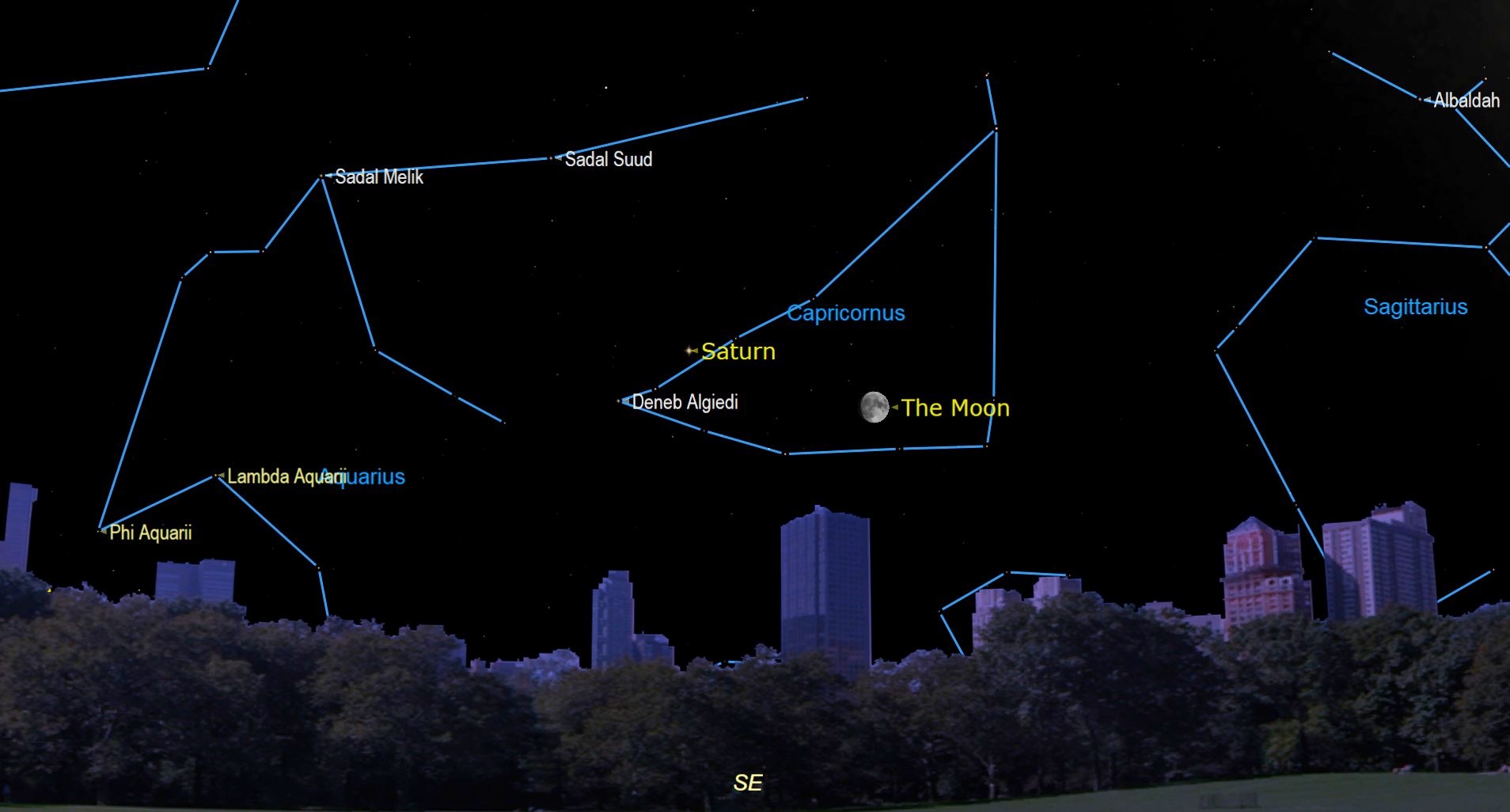See the conjunction of the moon and Saturn on Thursday (Sept. 8)
The second largest planet in the solar system will pair up with the moon over New York in the evening on Thursday.

On Thursday (Sept. 8), the moon and Saturn will make a close approach to each other sharing the same right ascension , an event known as a conjunction.
The two objects will pass to within around 3⁰ 43' of each other in the evening sky and will be visible in front of the constellation of Capricornus. Over the sky of New York, the conjunction will be visible at around 7:33 p.m. ET (2333 GMT) and will be located to the southeast about 13⁰ above the horizon. (A fist at arm's length equals roughly 10⁰.)
The moon and Saturn will reach 33⁰ above the southern horizon at around 11:14 p.m. ET (0314 GMT on Sept. 9) — the conjunction's highest point — and the event will continue to be visible until around 3:29 a.m. ET (0729 GMT), at which point the moon and Saturn will disappear between the horizon in the southwest.
Related: Night sky, September 2022: What you can see tonight [maps]
The conjunction of Saturn — the solar system's second-largest planet — and the moon will be best seen by the naked eye or with a pair of binoculars. A telescope won't be suitable to view the event due to the large separation in the sky between the moon and the gas giant which exceeds a telescope's field of view.
During the conjunction, the moon will have a visual magnitude of 12.7, while Saturn's magnitude will be 0.3.
Saturn is the sixth planet from the sun and one of the five brightest planets in solar system — also including Mercury, Venus, Mars, and Jupiter — that can be seen with the naked eye.
Get the Space.com Newsletter
Breaking space news, the latest updates on rocket launches, skywatching events and more!
Seen from Earth with the naked eye, Saturn appears as a twinkling speck of light, but it takes no more than a small telescope to see one of the planet's most astounding features — its rings. Embedded with these rings, which are believed to be material ranging in size from dust-like particles to car-sized lumps, are some of Saturn's moons.
Appearing as a hazy brown-yellowish blob in a telescope, the atmosphere of Saturn is mostly comprised of hydrogen and helium with relatively high amounts of methane and ammonia.
Conjunctions like this one between the moon and Saturn are a type of close approach in the sky between two or more astronomical objects called an appulse.

Looking for a telescope to see the moon or Saturn? We recommend the Celestron Astro Fi 102as the top pick in our best beginner's telescope guide.
The most frequent type of appulse involves the moon paired up with one of the solar system's planets. This is because the moon moves rapidly through the night sky in comparison to other cosmological bodies and can, therefore, pass through each constellation around once a month.
As a result conjunctions between the moon and the planets occur roughly once every month and at approximately the same time each month.
There is no strict definition of just how close two celestial bodies have to come in the sky to make an appulse. Astronomy website In The Sky considers an appulse to have occurred between two objects that are visible with the naked eye when they pass to within 3⁰, and objects visible only by telescope are in applause when separated by just 1⁰.
The next conjunction between the moon and Saturn is set for Oct. 5, 2022.
You can check out our guides for the best binoculars and the best telescopes to spot the moon, Saturn or many other celestial objects. If you're hoping to capture a good photo of the duo, check out our recommendations for the best cameras for astrophotography and best lenses for astrophotography.
Editor's Note: If you snap a photo of the conjunction of the moon and Saturn and would like to share it with Space.com's readers, send your photo(s), comments, and your name and location to spacephotos@space.com.
Follow us on Twitter @Spacedotcom or on Facebook.
Join our Space Forums to keep talking space on the latest missions, night sky and more! And if you have a news tip, correction or comment, let us know at: community@space.com.

Robert Lea is a science journalist in the U.K. whose articles have been published in Physics World, New Scientist, Astronomy Magazine, All About Space, Newsweek and ZME Science. He also writes about science communication for Elsevier and the European Journal of Physics. Rob holds a bachelor of science degree in physics and astronomy from the U.K.’s Open University. Follow him on Twitter @sciencef1rst.










